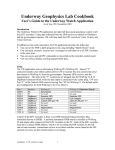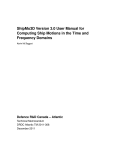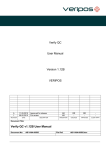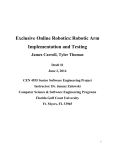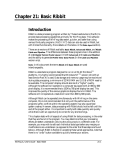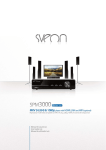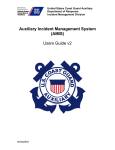Download Review the complete paper - Dynamic Positioning Committee
Transcript
Return to Session Directory Gabriel Delgado-Saldivar The Use of DP-Assisted FPSOs for Offshore Well Testing Services DYNAMIC POSITIONING CONFERENCE October 17-18, 2006 Risk Sedco Express DGPS Operations – Five Years of Lessons Learned Stephane Angue Transocean, Inc. Lew Weingarth Transocean, Inc. Stephane Angue & Lew Weingarth Transocean Sedco Express DGPS operations Introduction While serving as a DPO on the Sedco Express, I have learned that reliable, continuous and accurate position reference is central to the DP function. Also, an often overlooked but critical component of DGPS (Differential GPS) performance, particularly during a DP event or equipment failure, is operator judgment and experience. The DP operator must quickly and correctly deal with fault, loss of performance and simply failure of these position references systems. A good understanding the DGPS systems, their interfaces, and how the data is processed by the DP System is essential to maintain safe and efficient DP operations. DGPS technology constantly evolves. As DGPS manufacturers provide new systems with extra features and improved reliability, these systems also become more complex, and thus more difficult to operate. Simplification of the user interface would benefit vendors and drilling contractors as much as DPOs. On the Sedco Express we have used three different types of DGPS equipment in three different operating areas. We would like to share our experience with our DGPS and DP system during drilling operations as the rig moved between Egypt, Brazil, and West Africa. This paper will discuss the limitations, the deficiencies, and failure modes of DGPS in drilling operations, and suggest possible improvements. Presentation of the Sedco Express The Sedco Express is designed for ultra-deepwater environments and fast mobilization. The power plant, DP System, variable speed azimuthing pod propulsion systems and hull designs were optimized to achieve rapid change between drilling and transit operations and an estimated 10 knots self-propelled speed.. Because the rig design allows fast relocation, the Sedco Express has moved a lot in the last few years, and observed DGPS performance in three widely separated areas of operation, Egypt, Brazil, and West Africa. The DP system is an Alstom-Cegelec 903. The bridge is also equipped with an integrated vessel and power system. The Sedco Express is classified as a DP class 3 drilling rig. 3 position reference systems are available on board, 2 DGPS systems and 1 acoustic system. The acoustic system is a Sonardyne and consists in a dual LUSBL (long and Ultra Short base line) system (master/slave). The system can operate in both narrow band frequencies and wideband signals. The last upgrade to add wideband capabilities significantly improved the resolution and stability of acoustics, allowing better evaluation of DGPS performance. The DGPS systems are provided by FUGRO SEASTAR and FUGRO CHANCE. They are fully separated in both hardware and software. These systems were installed new in April 2005 during our last ship yard and commissioned in May 2005 before the passage to West Africa. Dynamic positioning conference Stephane Angue & Lew Weingarth Transocean Sedco Express DGPS operations Where have we been since 2000? The Sedco Express was built in France, and our first contract started in Egypt in September 2001. We left the Mediterranean area in July 2002 and worked in Brazil until January 2005. We left South America in May 2005 for Angola, where the rig is presently drilling. During these 5 years, we operated in various environments and different atmospheric conditions. This provided a wide range of data to evaluate the performances of the rig, and positioning equipment. Over the past 5 years, we experienced a significant amount of low quality DGPS signal and multiple rejections of the original satellite position reference systems. The identified causes were the low quality of correction signal and multiple failures or loss of performance of GPS receivers. Periods of unavailability corresponded mostly to heavy scintillation periods (due to loss of GPS satellite tracking and loss of differential correction link) or other bad weather related periods (causing disruption of our radio (HF/MF) links). We have also experienced problems with our new DGPS systems, due principally to software failures after commissioning. Comparing the original and the new systems we have determined that the new one is providing a more reliable and steady position to the station keeping system. DGPS systems specifications and philosophy on board Sedco Express The Transocean Engineering Department maintains comprehensive technical specifications for Satellite position reference systems (SPRS) in order to optimize performance and support across the fleet. Transocean’s philosophy is to consider these major points regarding purchase and installation of a SPRS: - 2 separate SPRS suites, each of which should differ from the other in both hardware and software to the greatest degree practicable to avoid the possibility of common fault modes. Dynamic positioning conference Stephane Angue & Lew Weingarth Transocean - Sedco Express DGPS operations All new GPS system should be dual-frequency designs to provide additional accuracy and reliability during increased ionospheric delay caused by solar storm activity. Selection of proper correction signals type and corresponding commercial correction services. Redundant corrections signals (redundant frequency band, receiver antennas, and sources) Hardware installed to receive MF radio beacon differential corrections signals. Power supply installation including UPS. Separate UPS feeding each SPRS. User friendly system All equipment in the SPRS suite shall be suitable for the area in which it is to be installed and operated. All SPRS suites shall comply with any established industry standards for reliability, fault tolerance, and fail safe behaviour. Avoidance of expiration dates for software and signals, maintenance of at least 12 months remaining subscription validity, and staggering of expiration dates so that no more than one device will be affected if an expiration date is inadvertently exceeded. On most vessels an uncorrected position is sent directly to the DP computer and corrected for antennae offset, and vessel motion by the DP Software. The Sedco Express class DGPS design calculates the 3 dimensional motion compensated position of the rotary table and sends this corrected position to external users (DP, wire line, etc) In addition to antenna differential corrections (the word “differential” will be used for all types of position corrections such as L1/L2, HP, XP, Ionofree, etc.), an offset calculation is made to the rotary table position. GPS receiver Differential corrections Antenna DGPS position calculation And QC GYRO MRU Offset calculator (rotary table position) Message to various users DP system, radars, GMDSS, client Figure 1: Block diagram of a SPRS design on Sedco Express This offset calculation is done by software running on different computers (usually navigation software like Winfrog or Seastar Seis) and requires the addition of Gyrocompass and VRU inputs. This design offers enhanced capability (we can use it during transit as navigation software) but it also increases the chance of failures and calculation errors due to the additional equipment connected and used to provide the final SPRS position. An enhanced redundancy philosophy is applied to all components of the suite, including sensors like gyrocompasses and VRUs. While increasing the ability to survive equipment failures, this also increases system complexity, adds failure modes, and increases the quantity of hardware and software the DPO must master. The original SPRS suite on the Express was replaced in 2005 for the following reasons: The same software and identical hardware were used by both Systems, which can cause a common failure mode. Obsolete GPS receivers Dynamic positioning conference Stephane Angue & Lew Weingarth Transocean Sedco Express DGPS operations No more vendor support Poor performance during ionospheric delay periods New sensors and software were available that perform significantly better Similar systems have been installed on board all 3 Express class rigs, differing in few hardware aspects due to operating area and client preference. DPO background and areas of influence Different type of DP operation leads to different position reference system operations philosophy. DPOs perform a wide range of operations depending on the vessel they are working on. SPRS performance requirements for a Drilling Rig are different than on a diving support vessel or crane barge. This statement is very important in order to understand the following sections. DP drilling operations are mostly concerned with monitoring system performance to make sure we remain within a specified maximum distance from our set point, or commanded position. This task can be boring, but the ability to stay focused during long periods of inaction is essential to be ready to react efficiently to an unexpected event. In addition to Operating DP, DPO work on the Sedco Express includes running the power plant, additional tasks like ballast control, radio communications, and other administrative duties. Two DPOs share the bridge watch. Marine DP SYSTEM background Position reference systems Reporting Checklists paperwork DPO Electronic Mechanical background VMS system DPO Emergency duty Deck background Navigation equipment Deck/drilling operations Ballast control Figure2: DPO background and areas of influence What is a DPO and what should he be familiar with in order to operate the position reference systems? A DPO operator is not a surveyor but he must know enough to understand what he is looking at on the positioning system display (acoustic or satellite) to react to any malfunction in the calculation process. He must also be able to deal with different types of coordinates and understand their differences. A DPO is not an electronic technician, but he must understand the technology well enough to mitigate the effects of any fault or failure, as well as give accurate guidance to an electronic technician to help solve the problem as quick as possible. A DPO is not a computer specialist, but he must understand the software, architecture, systems and subsystems well enough to know how to deal with a software fault on any of the different software and computers he controls (acoustic software, DGPS software, ICS (Integrated control system) software, ballast Dynamic positioning conference Stephane Angue & Lew Weingarth Transocean Sedco Express DGPS operations control software, data logger software and of course DP software). These particular skills in computer and software technology may also be essential to provide key data and information the vendor requires to quickly resolve problems. The DPO on the Sedco Express also manages the power plant, (engines, generators and all associated auxiliaries such as cooling systems, ventilation) and liaises closely with all maintenance department in case of equipment failure. He is also in charge of the day-to-day ballast control operations, and has important duties during emergencies (fire, gas event) and in all safety aspects of the rig operations (lifeboat coxswain, fire and gas system operator, and safety equipment maintenance). A significant level of knowledge is required to master all of these tasks, so there is a strong incentive to make each sub-task as simple as possible in order to shorten the time required to achieve competency. What should a DPO expect from a SPRS? The SPRS represents a small but very important part of the wide area of DPO knowledge and responsibility. Ideally, the DPO would prefer a position reference system that performed reliably forever with no action or input required by the DPO. In “real life”, however, this does not happen. Given that some user intervention will be necessary, the DPO would like to see the SPRS provide as a minimum: - Accuracy - Reliability - Steadiness of position (low variance/repeatability) - Low cost maintenance - Easy man machine interface - Easy data download and analysis It is noteworthy to mention that on a drilling rig, accuracy, while desirable, isn’t critical. Stability of the DGPS position solution and reliability of the DGPS equipment are more important for drilling applications [than accuracy]. Any drilling rig DPO would gladly accept an stable error of several meters as long as the position solution was stable and the equipment reliable. Reliability is what a position reference system must provide first. System reliability can be analyzed depending of the sort of fault. Regarding our SPRS systems we associate reliability to system redundancy: -Failure covered by internal system redundancy and mitigations a) Loss of differential correction: different correction link services in use b) Loss of primary GPS receiver (hardware failure): backup receiver installed (only on one SPRS suite on board) c) Loss of Gyrocompass or VRU (hardware): secondary gyrocompass and VRU input to each unit. d) Improper installation: Most of the equipment are redundant (differential signals services, receivers) e) Operator error: redundancy allows rapid identification of human error. -Failure not covered by system redundancy, and mitigations a) Software failure: Commissioning and vendor testing programs help but experience shows that even after extensive pre-deployment testing, software failures still occur. Also, software patches created to correct existing problems often introduce new problems. b) Computer or HDD (hard drive disk) failure: Although the hard drive is not redundant, failure of any system is accepted by class as long as other systems are functional. Potential means to improve reliability are carrying a spare HDD, or utilizing a new design with a solid state HDD. c) Loss of performance of any equipment not detected by SPRS software (e.g. drifting Gyro or VRU will cause an inaccurate and unreliable DGPS position sent to the DP software if not detected by the operator). Dynamic positioning conference Stephane Angue & Lew Weingarth Transocean Sedco Express DGPS operations Internal data checks (voting, median, drift tests) similar to those used by DP systems could be put in place, but additional complexity might negate the gains. d) Operator error: some of operator action could fail the SPRS system (DPO or ET) . The best mitigation is increased reliability (so tweaking isn’t required) and procedures to reduce risk. Good maintenance and operator training also serve to improve reliability and performance of the systems. Position reference system and DP system The DP operator has a direct influence on the interaction between the DP system and position reference systems. All DP systems perform quality checks on position reference signals. On the Sedco Express, these include: Prediction test Variance test Hardware / system problems : Freeze test: Median test: Signal latency/age: Within limits, the DPO can modify settings for signal rejection for most of these parameters. It is critical that the DPO understand the logic of all DP quality checks. Settings that are optimal for one operating condition may cause rejection of an acceptable position reference under other conditions. For example, when the ionosphere is stable, the DPO can reduce the size of the median test to prevent small signal “jumps” from affecting the DP Model. However, during periods of high scintillation, satellite geometry or correction services may be affected, resulting in more frequent and larger position jumps. If the median check rejection limit or prediction window is set too tight, the DP system may reject all GPS data, which immediately forces the rig to cease drilling operations. To prevent downtime, the operator must know how to adjust test parameters to the actual situation. Additionally, the Alstom DP System on the Sedco Express allows the DP Operator to adjust the Kalman filter gain. The Kalman gain is used to adjust the relative weighting of GPS position data vs. DP Model estimated position, and is used in conjunction with the signal quality test settings to optimize handling of position sensor data. The DP Operator must understand how to set the Kalman gain correctly both for periods of noisy and stable sensors. … Kalman filter setting on DP software In the above sections we discussed how SPRS and DP systems interact, the principles, theory and points of interest. In the following section, we will examine reality; what the DP operator sees while on watch. We will also describe design of the different systems and compare the performance of each. Dynamic positioning conference Stephane Angue & Lew Weingarth Transocean Sedco Express DGPS operations SEDCO EXPRESS SPRS SYSTEM ANALYSIS (TRINAV / NEW SYSTEM) If he knows his job, 99% of the job of the DP operator on a drilling rig is performance management, monitoring equipment and systems and making minor adjustments to improve performance (the other 1% is spent reacting to failures or other unforeseen problems). In order to make this monitoring efficient, he must know what he is looking at and clear information must be provided to him on the different system display. The key to success is to fully understand the design of the systems and how to properly utilize data provided by the systems. The next pages will detail the different system designs, failures we experienced, and the advantages/disadvantages of each system. TRINAV system Description (drawing) Main Computer Main positioning antenna plus three antennas for Roll/Pitch/Yaw determination Backup position antenna Reference station data antennas Receiver 1 Receiver 3 Receiver 2 Receiver 4 Receiver 5 All inputs to the main computer are duplicated to the backup computer Gyro TSS VRU To DP system The Trinav system was the original SPRS installed on the vessel. It provided a good redundancy in terms of GPS receivers and correction services, provided a simple and clear user interface, and was easy to setup. Single software was running under UNIX O/S to provide the rotary table position to all DP computers. From October 2001 to March 2005 (when we replaced it with new SPRS suites), we never experienced a major break down of the system. However, we did experience numerous minor failures. Due to the lack of a reliable dual frequency receiver and ionospheric delay problems we suffered a lot of position reference rejection from the DP system even while adjusting weighting to mainly rely on acoustic reference and increasing prediction test windows for the SPRS. Poor reliability of GPS receivers was also a concern, mitigated by high level of redundancy of GPS receivers. Advantages/disadvantages table of Trinav Advantages Simple man machine interface / user friendly Good redundancy (receivers and corrections Disadvantages Poor system performance during scintillation Multiple receiver failure or loss of performances Dynamic positioning conference Backup Computer To DP system Stephane Angue & Lew Weingarth Transocean services) 1 GPS receiver and 1 RTCM link installed in other area than derrick (bridge mast) HF links available Operator / ET experience on system Spares on board Sedco Express DGPS operations No quality control except the DQI parameter Poor performance of dual frequency receiver Same software running on both unit RTCM link hardware failures (spotbeam, Microdome) Unix O/S No support Software failure and bugs No remote control of the backup room system Fault / failure experienced with Trinav SPRS A) 15 November 2002 – Model Control: Chronology: Scintillation was affecting the DGPS prior the event. 2216 all position references rejected by DP System quality tests. 2217 Yellow Alert activated manually by DPO 2217 Acoustic available and selected. In DP 2218 DGPS available, 7m drift off due to model control and unstable positioning prior the event 2231 position stabilized and Green light on. Explanation findings: Poor performance of DGPS during scintillation caused both DGPS inputs to be rejected by DP. Identical drift of DGPS caused rejection of good acoustic position reference. B) 26 June 2004 - Drive off: Chronology: DGPS 1 and 2 with DQI of 3 but variance was acceptable (<1m). 01 24 33 Acoustic rejected by DP system on median check. Both DGPS drifted to NW. 01 24 37 DGPS 1 rejected by DP system 01 24 38 DGPS 2 rejected by DP system. Entered model control. Yellow alert activated manually by operator. 01 25 14 Acoustic available and selected. Rig in Auto DP 01 26 05 DGPS 1 selected in DP 01 30 21 DGPS 2 selected in DP. Rig position stabilized 20m NW of original position. 01 35 52 Rig back to original position 01 43 00 Green light on Explanation findings: - DGPS 1 and 2 were setup differently (different GPS receiver and correction link) - DQI 3 indicates poor position precision - PME weighting was in auto. - Acoustic rejected on median check - DGPS 1 and 2 rejected on prediction test DGPS positing was affected by poor geometry and low number of satellite in use. GPS receiver unable to use low elevation satellites Dynamic positioning conference Stephane Angue & Lew Weingarth Transocean Sedco Express DGPS operations sonardyne pme eastings 26:29 26:15 26:01 25:47 25:33 25:19 25:05 24:51 24:37 24:23 24:09 23:55 23:41 23:27 dgps2 23:13 metres dgps1 30 25 20 15 10 5 0 -5 -10 -15 -20 time pme northings 2 04:26:24 04:26:12 04:26:00 04:25:48 04:25:36 04:25:24 04:25:12 04:25:00 04:24:48 04:24:36 -2 04:24:24 -1 04:24:12 0 04:24:00 metres 1 sonardyne dgps1 dgps2 -3 -4 time C) 22 November 2004 - Loss of performance on DGPS #2 unit: At the time, we were suffering loss of Spotbeam differential correction link which was used as primary solution on the list. Other list solutions were showing at 141kms from the actual well position except the primary one. Every time we were losing spot beam signal, the software switched to second available solution in the list, at 141kms from the actual rig position causing PME to be rejected in DP. This problem was solved after investigation by resetting all GPS receivers and differential link systems. Dynamic positioning conference Stephane Angue & Lew Weingarth Transocean Sedco Express DGPS operations SEASTAR DP / MULTIFIX-WINFROG system SPRS suites The 2 new SPRS suites installed on board in April 2005 are provided from different vendors and use different hardware and software. Only the satellites, atmosphere, and Inmarsat B antenna are common to both systems. The Seastar DP (DGPS#1) is installed on the bridge. The Multifix /Winfrog system (DGPS#2) is installed in the backup DP room, with a remote display, mouse, and keyboard installed on the bridge. . Commissioning was conducted in Brazil before ocean passage to Africa. Problems were found during the transit and system upgrade, and repairs were performed prior to commencing drilling operations in Angola in June 2005. Description (drawing) a) Seastar DP (DGPS #1) The Seastar DP system provides redundancy in GPS receivers, Differential links, and auxiliaries (Gyrocompass and VRU). It uses both HP and XP solutions to provide very accurate position. The system also uses a complex suite of software programs and hardware. Despite extensive software testing during installation and sea trials, several software faults were discovered after the rig departed for Africa. None were “show stoppers”, but all were worrying because the complex interface increases operator uncertainty about possible knock-on effects. Dynamic positioning conference Stephane Angue & Lew Weingarth Transocean Sedco Express DGPS operations The most recent problem has been investigating why the input / output software manager (IOWIN) regularly crashes. Fugro engineering found a driver problem in the SPM2000 unit. The SPM 2000 uses a multiplexed output to send HP, XP position and type 15 message (ionospheric delays used for ionofree Calculation). Conflicts between this multiplexed output and IOWIN software were identified as the cause of occasional crashes of IOWIN. The SPM 200 setup was changed to eliminate IOWIN crashes. This change reduces flexibility, but increases system reliability (no more IOWIN crashes). However, this modification did not cure the problem and further fixes were proposed but we are now reluctant to perform them before a full assessment of the fault is done. Computer restarts are also a concern as we are experiencing difficulties in recovering the system after computer reboot. Both faults may be related and investigation is on going to determine the origin of the failures. b)Multifix4/Winfrog (DGPS #2) This system is more simple (design wise) than the Seastar DP. The weakest point (in our opinion) is the absence of a backup GPS receiver. Software performance is satisfactory but as with the other vendor system, despite extensive testing before and during sea trials, a few software bugs remain. Dynamic positioning conference Stephane Angue & Lew Weingarth Transocean Sedco Express DGPS operations Advantages/disadvantages (new SPRS suites) Advantages 2 separate and independent systems (different hardware and software) XP (orbital and clock corrections) Redundancy of RTCM correction type and link Vendor Support Quality control on multifix Remote control of the backup room system Very good repeatability/variance Disadvantages All equipment installed on top of derrick No backup receiver on the Multifix/Winfrog system Poor reliability of the HP solution on Seastar DP system Unable to adjust setting in DP large enough for maximum age of corrections. Complicated for DP operators and ET’s Spare parts (expensive) / None on board Download on same machine. Can’t stop operations to replay data High tech equipment (receiver/computers) Able to use GPS without the “D” Faults / failures experienced on the new SPRS suites Corrupted VRU data degrading DGPS#2, causing DP to reject motion compensated position Poor reliability of HP solution on Seastar DP (DGPS#1) (more than 1000 solution resets in less than 300 days of operation). It is unknown if this problem is inherent to the operating area or a software problem. Computer failures and rebooting problem on Seastar DP(DGPS#1). Input / Output management software (DGPS#1) multiple crashes resulting in position reference rejection on DP system. We received feedback about this one (see above) Software glitch on Multifix software (DGPS#2): Every Sunday at 0000GMT the latency figures show -62s, which causes the DP software to reject the position reference. SPRS suite / DP non compatibility regarding age of corrections: XP type correction can be used longer than HP or Ionofree correction type (up to 240 seconds v. 60 seconds for station-based corrections). The original DP software design doesn’t allow the “latency test” to be set longer than 100 seconds. Thus, XP solutions older than 100 seconds are rejected by DP. A DP software change is planned to extend the acceptable age. Concerns for future The major concern we have regarding the DGPS system is GPS receiver redundancy. We do not have a backup receiver for one system. The time required for the vendor to ship a replacement receiver to the rig in West Africa could reduce the level of position reference redundancy for a significant time. This must be addressed by increasing the level of rig spares on hand. Our more immediate concern is the type of failures we experience with these high tech systems. Although these systems fail less than previous generation, the failures are much more complicated, take much longer to solve, and usually require vendor support. Software faults often require months for the vendor to figure out what is wrong and develop a patch that doesn’t decrease performance. Quick solutions that “short circuit” the fault often decrease the system capability and performance until a proper patch is developed. There is also the concern that software changes may introduce new and potentially worse faults, because vendors cannot exactly duplicate the conditions experienced by the rig and thus cannot be 100% sure that bug fixes are themselves bug-free Dynamic positioning conference Stephane Angue & Lew Weingarth Transocean Sedco Express DGPS operations The operator interface is also an issue. Complex software interface and menu design confuse the operator and increase the chance of input error, particularly by new and inexperienced hands. DP DGPS input has been lost more than once due to relatively simple operator mistakes. ANALYSIS AND STATISTICS The next section reviews the occurrence of position reference equipment failures and their effect on the DP system over the last five years. The Above graphs show 37 classified DP events recorded on the Sedco Express since January 2002. 4 DP events were classified as position reference cause (11%). Two (2) DP Events related to SPRS led to a Yellow alert condition (6 yellow alert condition have occurred on board since rig start up) which was related to a failure or loss of performance. It is interesting to note that the SPRS-related DP events represent 33% of the yellow alert conditions we experienced during the sample period. This clearly shows the criticality of SPRS reliability to station keeping reliability. Dynamic positioning conference Stephane Angue & Lew Weingarth Transocean Sedco Express DGPS operations Recorded position reference input rejections by DP system since October 2002 (to august 2006) A position reference rejection by the DP system means that the DP system rejected the position fix for various reasons: fail on prediction test, fail on median check, failure on data message link or age of correction above latency limits. The above graph shows the rejections of position reference systems we have experienced since October 2002. From 2002 to 2005 with the Trinav system and from June 2005 with the new SPRS suites, the ‘weekly bug’ rejections experienced on the Multifix/Winfrog suite are not taken in account as we know to expect it every Sunday at the same time and for the same duration. We avoid this fault by changing the solution in use. We can see on the above graph the scintillation periods we experienced in Brazil in 2003 and 2004. Most of position reference system rejections we had during these periods (October to February) happened during scintillation periods but some of them were due to poor performance of GPS receivers and noisy reception of differential signals. In all cases, SPRS were reselected in a reasonable time after operator action (system setup changed) or at the end of the scintillation period. The acoustic position reference system has been very reliable since the beginning of the operations (except the start up period while we were still improving our knowledge of the system). A few of these rejections were due to close proximity operations with other ships using the same acoustic system, but most were due to SRPS. Trinav GPS receiver’s poor performances and failures degraded the average performance of both systems. Because of its good redundancy we never suffered any long term unavailability. SPRS performance has improved since the systems upgrade (except the bad DGPS system message sent to DP every Sunday at 0000). The following graph shows the amount of time position reference systems have been unavailable while operating with the new SPRS systems in Angola (since June 2005). This is the actual recorded time (on Dynamic positioning conference Stephane Angue & Lew Weingarth Transocean Sedco Express DGPS operations DPO log) that the position reference systems have been deselected from the DP system due to repair or reinitializing after failure. Main DGPS #1 unavailability resulted from computer failures (mouse problem and rebooting trouble after IOWIN software crashes in March) and differential signal loss during AF-SAT maintenance. Main DGPS #2 recorded failures resulted from a VRU failure degrading the DGPS solution. Failure to quickly identify quickly the fault, due to the complex user interface and operator unfamiliarity, extended the length of time the system was unavailable. The main Acoustic recorded failure resulted from a communication fault between the master and slave position processor units, which required a full reboot of both consoles. None of these faults caused station-keeping problems and none was classified as a Yellow or Red DP event, but the operating status was changed to advisory during the period of unavailability. Use of these high technology systems has provided enough experience for us to suggest ideas to improve these SPRS systems for drilling operations. As said previously, Drilling Operations require a slightly different approach to position reference systems than other final users. A feature that is ideal for a pile lay vessel may hinder a drilling rig, and vice versa. Possible improvements We have identified two areas in the SPRS design where we think improvement could be interesting. management of system redundancy operator interface Dynamic positioning conference Stephane Angue & Lew Weingarth Transocean Sedco Express DGPS operations a) Management of system redundancy: It is important to limit operator input to a minimum because of the variability of DPO experience and ability. The system should be designed to continue operating despite the failure or loss of performance of any single component, and without any operator input. Regarding this, we suggest the following possible improvements: Hardware: 1) All systems should be designed with a Backup GPS receiver: In case of failure of the main receiver on this system we could suffer long-term position reference unavailability due to absence of spare parts on board and the time needed to bring a receiver on board (rig is in Africa). Our Multifix/Winfrog system is installed without a backup receiver. 2) The backup receiver (associated with a correction link) should be installed in a different area than the primary receiver in case the area is lost (derrick incident or any physical damage to the installation area which could affect both receivers. A separate emergency power supply may also be considered between the primary and backup receivers and correction link. 3) A radio correction link should be available when possible. Presently, corrections are provided by separate satellite links (Spotbeam and Inmarsat). If the rig is drilling in an area where a strong HF Radio transmission of differential corrections is available, consider adding this feature to increase overall system reliability 4) Install an independent data logger: Both systems are installed with QC and download capability but once we are connected we are reluctant to do anything which could cause disturbances to the DGPS computer (like downloading data). It is also not possible to replay data while the system is online. An external data logger collecting data from both DGPS systems (similar to DP data logger) would improve data analysis and monitoring. Software: 1) Output solutions from the DGPS unit should be stopped if no Gyrocompass or VRU are available for the offset and motion calculations. The Winfrog software is set to use the COG (course over ground) data as heading value in order to compute this offset position in case of gyrocompass failures. This is hazardous as during station keeping the rig is stationary, thus COG is usually meaningless. This may cause unexpected disturbances to station keeping. Stopping the data is preferable to sending incorrect data. 2) Both GPS units use the same philosophy to select the primary DGPS solution. The user manually sets the priority in which solutions are used. If the primary solution fails, the DGPS system selects the next available solution to send to DP. When the primary solution becomes available again, the system automatically switches back to it. This may present a problem if the primary solution is intermittent. Rather than the computer automatically making the switch, the user should decide whether or not he wants to re-select a solution after it recovers. The system should keep the next priority solution selected, and invite the user (through a dialog box informing that the primary solution is back, ‘do you want to select it or not?’) to re-select it or not. Most of the time, the DPO would prefer to monitor the solution performance before re-selecting it as primary. The same should be done for gyrocompass and VRU selection. If a sensor fails and returns, the system should not change back to the first priority sensor without input from the DPO. b) Operator interface: The SPRS displays provide a lot of information to the operator, maybe too much. The menus are complex and input errors are allowed. Software functions, which the Operator regularly uses and those he almost never uses, are intermingled on screens rather than presenting the vital functions and placing infrequently Dynamic positioning conference Stephane Angue & Lew Weingarth Transocean Sedco Express DGPS operations used inputs on another screen. Also, an audible (or at least visible) warning/alarm function should make the operator aware of any system configuration change. Operator display: 1) A scatter plot graph with all different calculated solutions (in the idea of the Multifix 4 but for the motion compensated solution not for the antenna position) 2) An alarm function to inform the operator about any change in the configuration or any failure. 3) The possibility to insert a type of watch circle around an initial position to detect drift from any of the list calculation. The Seastar DP provides Delta east and Delta north deviation from the primary solution but a graphic would be more efficient for the operator. System access (operator input control) 1) The SPRS software does not ask for a confirmation for any parameter change or action done on the system via a dialog box (such as the DP software requesting an operator confirmation for any actions). It would be a safeguard to the whole DP operation to add that kind of facility as this situation has happened more than once when an operator closed the wrong window or stopped the software by mistake. 2) There needs to be a way for the operator to select which solution to be output as the final SPRS solution (and sent to the DP console) without travelling through different menus. A simple tick box facility next to each list solution on the main display could be a solution to implement it. 3) Also needed is authorized access to the configuration menu only through a password system. An individual operator-logging password system could be also implemented. It will reinforce the accountability of the operator by allowing post tracking of all change performed. Training As shown above in the previous pages, it is essential for the DPO to acquire knowledge and experience in the numerous disciplines to efficiently perform his task. Position reference system and SPRS in particular is only one area. If most of operators (from merchant navy or from technical background) have a basic knowledge of GPS system, only a few of new operators arriving on the field will have an advanced knowledge of the systems we use. We develop on board a training scheme to help them to build the necessary knowledge. The company is also offering through the DP lesson learned course the related material and explanations in order for all fleet operators to improve their capability in the use and understanding of these new systems. Conclusion On board the rig, we use to say that engineers design equipment or systems thinking that these functions will never fail. In the field, the equipment is stressed 24 hours a day, exposed to a range of environments, and we just wonder how long it will be before it will fail, and what will happen if it fails. Nothing lasts forever and everybody knows it is just a question of time. It is a part of our task (both engineers and operators) to prevent this moment as best we can. Regarding SPRS on board our drilling rig, a good system redundancy, proper operator training and instructions and high standard maintenance will help to maintain system reliability and performances at the highest level. These 2 SPRS suites that we installed last year will also become obsolete one day, maybe because the GPS system will stop or because more accurate and more reliable positioning equipment will be available on the market. DPOs will have then to adapt themselves using new equipment, new positioning philosophy and Dynamic positioning conference Stephane Angue & Lew Weingarth Transocean Sedco Express DGPS operations will need to acquire new knowledge on equipment which will certainly be more technical and complicated to handle. Glossary and definition: DGPS: (differential GPS) is an evolution of GPS system by an addition of corrections to GPS satellite signals to remove different errors in the final position induced by atmospheric disturbances, GPS satellite ephemerid and almanacs errors and other sources of errors (multipath, orbital errors, clock error). A GPS receiver is installed on a known point on earth and a comparison is done between the GPS calculated position and the known position. Then, corrections can be calculated for each satellite signal (ranges) and transmitted by RF (radio frequency) or satellite link to mobile GPS units DP (dynamic positioning): “A means of holding a vessel in relatively fixed position with respect to the ocean floor, without using anchors accomplished by two or more propulsive devices controlled by inputs from sonic instruments on the sea bottom and on the vessel, by gyrocompass, by satellite navigation or by other means.” (Reference: Mr. Holvik DP basics, DP positioning Committee 1998) GPS: (global positioning system) is a positioning system using a network of satellites traveling on different orbits to position mobile receivers by triangulation of satellite signals, technically at least 3, but usually 4 or more. HP correction type: Traditional decimeter level service based on a network of DGPS reference stations and transmitting correction to the user. PME: Position Measuring Equipment = position reference system SPRS: satellite position reference system QC: quality control XP correction type: Utilizes reference stations with a worldwide spread to calculate the orbit and the clock value of each GPS satellite more accurately than the broadcast GPS ephemeris. Orbit and clock corrections to the broadcast ephemeris are then transmitted to the user. These corrections are valid worldwide and the distance from the nearest reference stations to the user does not affect the performance. References -Satellite position reference systems, equipment standards, Transocean Engineering, 2003 -DP-committee proceedings and presentations, 1997-2005 -DP lesson learned course, Transocean, 2005 -Dynamic positioning OPL book (David Bray) -Alstom 903 user manual -Fugro Multifix, Winfrog & Seastar DP user manuals -Fugro installation reports, Sedco Express, 2005 Dynamic positioning conference




















